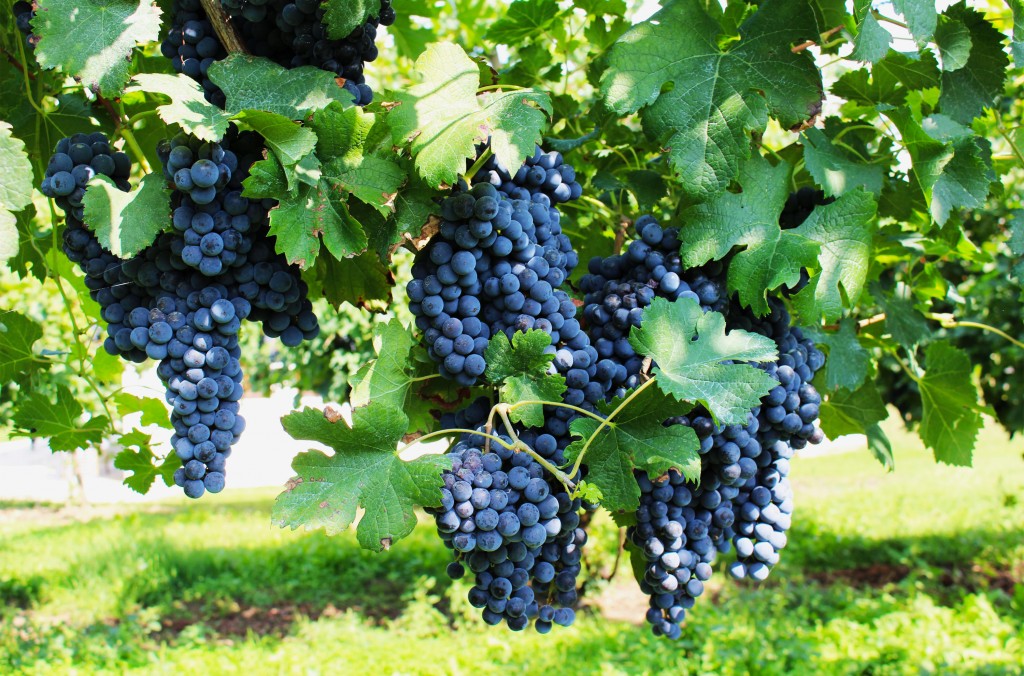
Pinot Noir (Pinot Noir) - the legendary variety from France, from which burgundy wine is made. Grown hundreds of years, distributed in different parts of the world. Vineyards with varieties of Pinot Noir and its clones are located in Europe, South America, the United States, New Zealand.
The taste of berries and productivity are affected by growing conditions, therefore, in each country, this variety manifests itself in different ways. This allows us to talk about the variety of taste shades of grapes, and hence the quality and aroma of the wines obtained from it.
Content
Grade characteristics
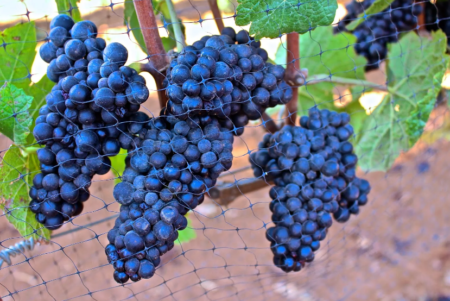
This grade It is part of a group of technical types of culture, obtained in France, as a result of crossing the famous dark Pinot Meunier and Traminer grapes. The best result in yield and taste of berries gives in Burgundy, in other regions the indicators are unstable.
Ripening periods vary from 130 to 145-150 days. Bushes are medium-sized, shoots grow straight. Young shoots are greenish, when ripening already by the first year, the color darkens, becomes dark brown. The leaves are small, with five distinct blades, while the central part of the leaf plate is widened. On the back there is a slight pubescence. Coloring is greenish yellow.
The vine ripens well, most of the released shoots are formed as fruitful (90-92%). The flowers are bisexual; replanting of additional grape varieties to Pinot noir is not required.
In terms of yield, Pinot Noir is inferior to many technical varieties. When grown on industrial plantations, up to 60 centners per hectare are obtained from it. The largest high rate is a little over a hundred centners. It grows better in regions with warm, but not hot summers. With a strong heat, the berries ripen early, not having time to accumulate the optimal balance of sweetness.
It is considered a moody variety, although it withstands frosts up to minus 23 ºC ... 30ºC degrees. When grown in risky farming areas, it is desirable cover the vine for the winter. The variety does not tolerate spring frosts, as it begins to open its eyes early.
When cultivated in various regions, it is prone to spontaneous mutations. Therefore, Pinot Noir in the United States, Japan or Russia is quite different from the Burgundy variety.
Fruit Description
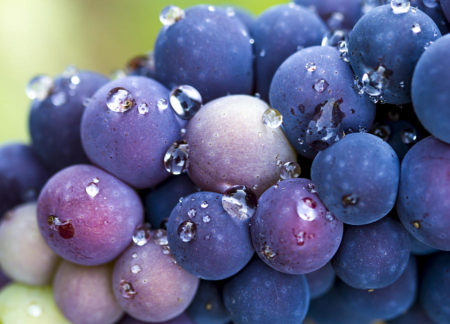
Not very large clusters are formed on the vine. The form is cylindrical, the density is high. Due to the outward resemblance to a pine cone, the variety acquired the name Pinot Noir, which means “black cone”. The crest is lignified, long. The weight of grape grones is 100-120 grams.
The berries are small, often deformed due to a very tight fit in the brush. The average weight is 1.2-1.5 grams. The skin is dark blue, almost black. The pulp is juicy, without mucus. The juice is colorless. The peculiarity of Pinot Noir grapes is a high juice content in berries, up to 70-78%.
There are few seeds inside, no more than 2-3 pieces. The taste is excellent, notes of fruit, berries (blueberries, currants) are felt. The originality of the taste is given by interesting shades of smoke, coffee, ginger.
With strong heat or prolonged rain and non-observance of the rules of agricultural technology in clusters, strong peeling is observed. The taste of berries is also lost.
The main purpose of Pinot Noir is wine making. The variety is appreciated for the harmonious combination of sugars and acid, which makes fine table wines and champagne. Sugar - 18-25, acidity indicators - 7-9 g / l. In industrial production both single-varietal wines are made (only Pinot Noir), and experiment by mixing it with other varieties (Pinot Gris, Chardonnay).
Advantages and disadvantages
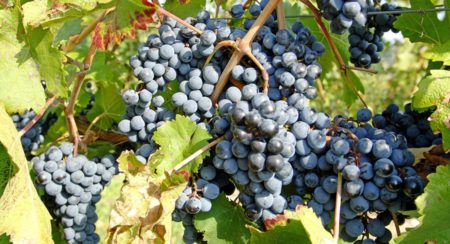
Bred in France, Pino Noir grapes are the progenitor of many varieties of the technical variety. Their advantages:
- medium-sized, compact bushes, which facilitates agricultural technology and allows you to grow grapes in small areas;
- rapid growth of substitute shoots (important if the bush is seriously frozen);
- frost resistance;
- excellent taste of berries as raw materials for wine production.
Pinot Noir gives amazing combinations of a bouquet of berry taste, therefore, despite capriciousness, valued by winegrowers around the world. The color of the drink is purple (from Burgundy Pinot Noir). The color of the wines from the clones of the variety varies from pale pink to white.
Disadvantages:
- high dependence of yield and taste of berries on growing conditions;
- susceptible to damage by gray rot;
- often affected by phylloxera, leafworm.
Among the techniques of agricultural technology are mandatory preventive treatment (all season) of the vineyard from diseases and pests.
Varieties of Pinot Noir
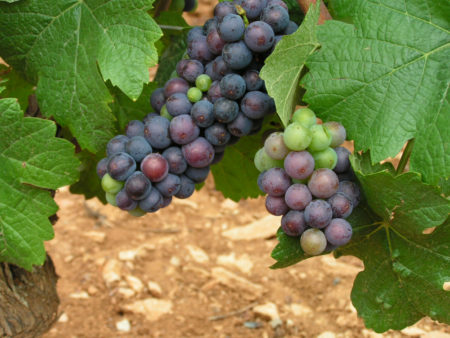
Attempts to grow famous variety from Burgundy were undertaken in the USSR, in the Russian Federation. Received three varieties with berries of black, white and grayish color:
- Pinot early (second name - Pinot Michurinsky);
- Pinot Fran (Crimean);
- Pinot is black.
Pinot Michurinsky was bred by Shtin domestic breeders. It differs in early terms of berry picking and frost resistance.
The growth force is low, forms 2-3 clusters on the vine. Formation, as well as rationing of the crop is required. The berries are oval, with juicy pulp and a thick spring layer on the skin.
Black Pinot is cultivated for landscaping, as in middle lane does not require shelter for the winter. The berries in the bunch are small, black in color, without aroma. The taste is pleasant, with a subtle sourness. Ripen early, after 110 days, the crop is ready for harvest.
Pinot Krymsky ripens more slowly, at least 150 days pass before picking berries. The clusters are small with lots of berries. The grapes are small, dark blue with a gray bloom. Due to the thick waxy layer, the clusters appear grayish, as if dusty.
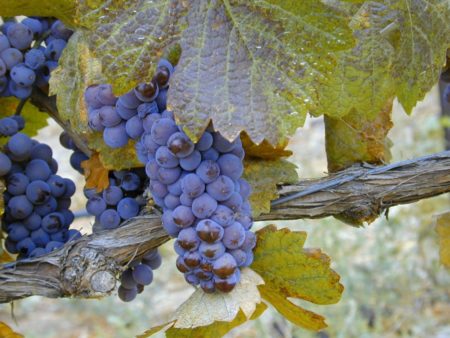
Pinot Fran winters in the south not bad, but can be affected by spring return frosts. Crops are small, grown due to the taste of berries. Used grapes in winemaking, as an additional component to wine materials in the production of champagne.
Grape planting
The variety is demanding on soils, lighting. They select the southern places of the site, preferably on the slopes.
Soil - limestone with clay, loose structure, crushed stone type. It is on this soil that Pinot Noir grows in Burgundy, in other regions it adapts to local soils.
It grows well on slightly acidic soils, pH - 6-6.5, responsive to the application of ash. Pits during spring planting are prepared in the fall. In the fall - 3-4 weeks before planting seedlings. Between the plants leave 80-90 cm, between the rows - 1-1.2 meters.
Mandatory availability of drainage, fertilizer (ash - 250 grams, nitroammophoska - 250 grams per pit). After planting, the soil is mulched by 8-10 cm with peat, foliage, straw.
Care
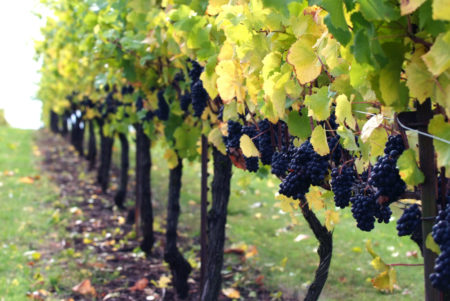
All attempts to grow a “real” burgundy grape in other countries were unsuccessful. Harvest Pinot Noir in the homeland is unique, a bouquet of taste of berries is unique. At the same time, winegrowers successfully grow Pinot Noir varieties, producing berries with different aromas and tastes. It is important to consider that this variety is very demanding on competent watering and top dressing.
Watering
Water abundantly, but not too often. It is recommended to make grooves, trenches, use drip irrigation systems that provide gradual moistening of the soil.
The first watering is in early spring, before the eyes are revitalized. When snowy winters are watered at the end of March, if enough snow falls, then irrigate the soil under bushes in April.
During flowering and two weeks before it, grapes are not watered. Pinot Noir is desirable to irrigate with water at room temperature, not cold and not overheated. 40-60 liters of water are spent on an adult bush in the summer. On sandy soils, norms increase, avoiding overmoistening. Watering depth - up to 50 cm.
Top dressing
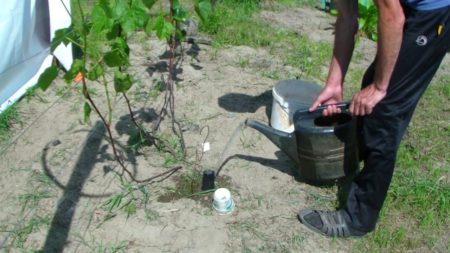
Technical grade is fed 3-4 times a season, starting from the age of three. Prior to this, the vineyard has enough nutrition laid during planting.
Sample scheme top dressing Pinot Noir:
- the first - before flowering, apply chicken droppings (40 grams per bucket of water), mullein (2 kg per bucket), nitrophos (50 grams per bucket).
- the second - two weeks before the formation of the berries, apply ammonium nitrate, Kalimag (20 grams per bucket of clean water);
- the third - 2-3 weeks before harvest, use potassium salt, superphosphate (20 grams per bucket of water);
- the fourth - after harvest, use fertilizers with components of phosphorus and potassium.
Effective spraying with boric acid (5 grams per bucket of water), contributing to an increase in clusters and the number of berries.
Formation
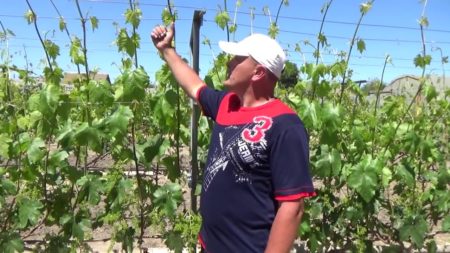
The Pinot Noir bushes are medium-sized, so the best formation options are:
- low bole (in the south);
- high boles with long sleeves (northern regions).
Growing in a high stem allows you to raise the bulk of the branches from the soil, improve lighting, airing the bushes. Significantly easier care, increased resistance of Pinot Noir to infections.
Cut shoots for 7 eyes (middle option). Formation and removal of branches with sharpened secateurs, with mandatory disinfection of the instrument in a solution of potassium permanganate. Sick branches, weak, non-fruiting and extra shoots are removed.
Disease Prevention and Pest Control
Grape sort Pinot Noir is medium resistant to defeat mildew and oidium. Gray rot is a danger, therefore, from early spring, winegrowers treat bushes with special preparations.
Processing:
- spring plants are treated with colloidal or garden sulfur, a solution of baking soda (0.5%);
- when the first leaves appear - with Actellik, Polyram preparations;
- before flowering, and then during the formation of grapes - preparations Topaz, Ridomil Gold;
- In autumn, spraying with DNOC, Nitrafen is effective.
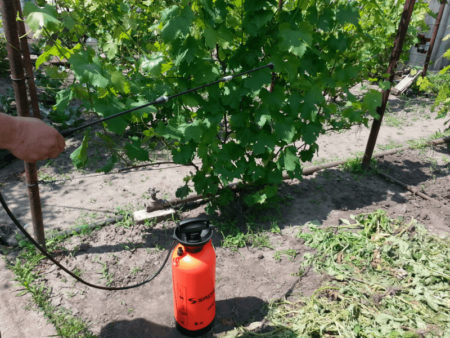
In the fight against gray rot, Bordeaux is used, a solution of potassium iodide. With a severe defeat of the vineyard, the bushes are sprayed with Rovral, Euparen (0.1%).
Pinot Noir is susceptible to chlorosis, so a small amount of foliage is cut off on the shoots for prevention.
Among the pests, the phylloxera is the worst enemy of the variety. In order to resist the pest, experienced winegrowers plant Pinot Noir bushes on varieties resistant to damage to grape aphids.
Spraying from phylloxera (in leaf form):
- the first treatment - with massive blooming of the kidneys;
- the second - with the formation on the shoots of 10-12 leaves.
Applied drugs Etafos, Maxi, Dilor.
Processing leaves by means of Ambush, Fozalon, as well as biological products, is saved from leaflets.
Harvesting
Berries ripen at maximum maturity. In the middle zone of the Russian Federation, the term is the beginning of September. Collect by hand, carefully removing the clusters from the vine.
Professional winemakers, after harvesting, squeeze clusters of Pinot Noir directly from the comb to get high tannins in drinks. Since the juice and flesh of the grapes are not colored, the berries are used to make red and white wines.
Pinot Noir is a legend of technical varieties that has earned the fame of one of the most “wine” grapes. Despite the fact that the “real” Pinot grows only in Burgundy, its varieties are successfully cultivated in different countries, receiving delicious juicy berries.
Reviews
Nikolay, Voronezh region
I tried to plant Pinot Noir, took from the nursery. I didn’t really like it: neither by the strength of growth, nor by productivity. The ripening time is delayed, so I’ll probably take it and pick up other varieties, more interesting.
Igor, Krasnodar Territory
I have already collected a different collection of Pinot clones, including, there are Crimean, Pinot gris, less and others. The main one is Pinot Fran, it is liked by its taste. I grow these varieties exclusively for making wine. The vine ripens well, the berries are dark, with a strong skin. The taste is pleasant. For me, there is only one drawback - the clusters are small in size and weight.

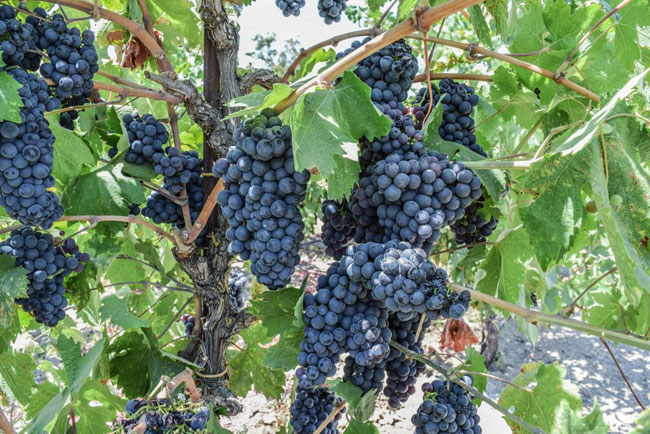



 Non-covering winter-hardy grape varieties for Moscow region
Non-covering winter-hardy grape varieties for Moscow region How to keep the vine in winter
How to keep the vine in winter When can I transfer grapes to another place in the fall
When can I transfer grapes to another place in the fall How to cover and prepare grapes for the winter in the suburbs
How to cover and prepare grapes for the winter in the suburbs